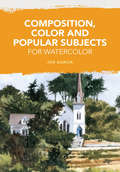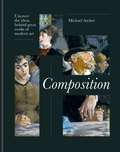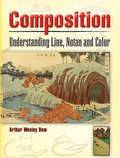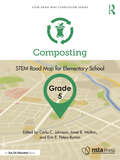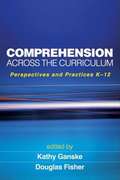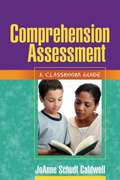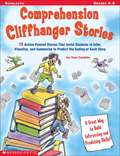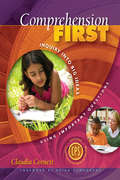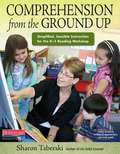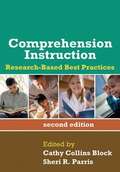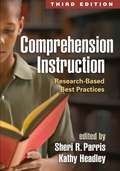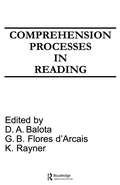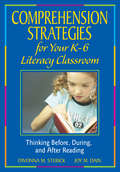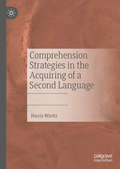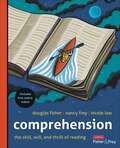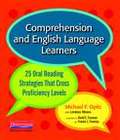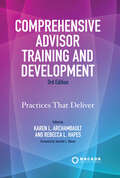- Table View
- List View
Composition with Vocabulary and Spelling IV
by ChapmanThis work text demonstrates the importance of structure and clarity. Focused on advancing students' writing, straightforward examples and step-by-step exercises guide students through drafting concise and coherent essays. Because choosing the correct words for written projects is vital, the text also includes twenty units of spelling/vocabulary lists. With twenty spelling words and twelve vocabulary words, each list focuses on Greek and Latin prefixes or roots, geographic locations, and specialized fields, such as history, fine arts, or sciences.
Composition, Color and Popular Subjects for Watercolor
by Joe GarciaLearn great lessons about how you can incorporate great design elements into your composition, including five easy formulas that will ensure a strong image every single time. But don't let your great design be ruined by muddy colors! These lessons go beyond color wheel instruction to teach how to achieve tones from skin color to sky and foliage, all of which sets up the final section, where you'll learn great approaches to popular subjects ranging from animals and nature to man-made objects.
Composition: The Anatomy of Picture Making
by Harry SternbergDifficult to grasp and harder still to achieve, composition is a chief concern of artists at every level. This clear and focused introduction exposes the compositional devices that underlie successful artworks. Its many examples reduce pictures to their basic formal elements, offering a concise treatment of an oft-neglected topic.Author Harry Sternberg, whose works appear in major museums throughout the United States, was a student and instructor at New York's prestigious Art Students League. He draws upon his extensive background as a teacher and professional to provide an approachable view of applying composition to graphic works. Novices and experienced artists alike will benefit from his well-illustrated explanations of handling such elements as the picture border, flat space, tensions, positive and negative space, geometric design, and volume, as well as the processes of analyzing pictures and communication through design.
Composition: Uncover the ideas behind great works of modern art
by Michael ArcherThe rules of composition have changed. Discover the new ideas that shape the art we make today. Art has changed beyond recognition since the principles of harmonious composition were established in classical times. From the invention of photography to the digital revolution, technological and social advances have transformed the way we see the world. This new vision, influenced by changing attitudes not least towards gender roles and the West's colonial history, is reflected in the art we make.From the rejection of Western compositional orthodoxy by artists such as Édouard Manet, Vincent van Gogh and Mary Cassatt to the revolutionary practices of Jean- Michel Basquiat, Tania Bruguera, Meleko Mokgosi and many others, acclaimed art critic and writer Michael Archer reveals the ideas and intentions behind a thrillingly diverse selection of artworks, giving readers a new set of tools for understanding art today.
Composition: Uncover the ideas behind great works of modern art
by Michael ArcherThe rules of composition have changed. Discover the new ideas that shape the art we make today. Art has changed beyond recognition since the principles of harmonious composition were established in classical times. From the invention of photography to the digital revolution, technological and social advances have transformed the way we see the world. This new vision, influenced by changing attitudes not least towards gender roles and the West's colonial history, is reflected in the art we make.From the rejection of Western compositional orthodoxy by artists such as Édouard Manet, Vincent van Gogh and Mary Cassatt to the revolutionary practices of Jean- Michel Basquiat, Tania Bruguera, Meleko Mokgosi and many others, acclaimed art critic and writer Michael Archer reveals the ideas and intentions behind a thrillingly diverse selection of artworks, giving readers a new set of tools for understanding art today.
Composition: Understanding Line, Notan and Color (Dover Art Instruction Ser.)
by Arthur Wesley DowAt the turn of the twentieth century, Arthur Wesley Dow literally "wrote the book" on composition—and this is it! Dow's Composition exercised an enormous influence on emerging modern artists of a century ago. A thought-provoking examination of the nature of visual representation, it remains ever-relevant to all the visual arts.A well-known painter and printmaker, Dow taught for many years at Columbia University and acted as a mentor to countless young artists, including Georgia O'Keeffe. His text, presented in a workbook format, offers teachers and students a systematic approach to composition. It explores the creation of freely constructed images based on harmonic relations between lines, colors, and dark and light patterns. The author draws upon the traditions of Japanese art to discuss a theory of "flat" formal equilibrium as an essential component of pictorial creation. Practical and well-illustrated, this classic guide offers valuable insights into modern design.
Composting, Grade 5: STEM Road Map for Elementary School (STEM Road Map Curriculum Series)
by Carla C. Johnson Erin E. Peters-Burton Janet B. WaltonWhat if you could challenge your fifth-grade students to investigate the role of composting in solid waste management? With this volume in the STEM Road Map Curriculum Series, you can! Composting outlines a journey that will steer your students toward authentic problem solving while grounding them in integrated STEM disciplines. Like the other volumes in the series, this book is designed to meet the growing need to infuse real-world learning into K–12 classrooms. This interdisciplinary, four-lesson module uses project- and problem-based learning to help students use the engineering design process (EDP) to design and create prototypes of compost systems and build a full-scale composting system for school use. Students will synthesize their learning about biotic and abiotic factors, decomposition, and engineering design as they learn about various types of compost systems, create their own portable compost bins, and create materials for a composting publicity campaign at their school. To support this goal, students will do the following: Identify and explain interdependent relationships in ecosystems Compare and contrast several ecosystems Describe how compost systems are designed and constructed and apply this understanding to creating prototypes of various compost systems Understand the concept of scale and apply this understanding to create scaled models of compost systems Apply their understanding of composting, compost systems, and the EDP to create a full-scale compost system for the school Measure various characteristics of compost The STEM Road Map Curriculum Series is anchored in the Next Generation Science Standards, the Common Core State Standards, and the Framework for 21st Century Learning. In-depth and flexible, Composting can be used as a whole unit or in part to meet the needs of districts, schools, and teachers who are charting a course toward an integrated STEM approach.
Composting, Grade 5: STEM Road Map for Elementary School (STEM Road Map Curriculum Series)
by Carla C. Johnson Erin E. Peters-Burton Janet B. WaltonWhat if you could challenge your fifth-grade students to investigate the role of composting in solid waste management? With this volume in the STEM Road Map Curriculum Series, you can! Composting outlines a journey that will steer your students toward authentic problem solving while grounding them in integrated STEM disciplines. Like the other volumes in the series, this book is designed to meet the growing need to infuse real-world learning into K–12 classrooms.This interdisciplinary, four-lesson module uses project- and problem-based learning to help students use the engineering design process (EDP) to design and create prototypes of compost systems and build a full-scale composting system for school use. Students will synthesize their learning about biotic and abiotic factors, decomposition, and engineering design as they learn about various types of compost systems, create their own portable compost bins, and create materials for a composting publicity campaign at their school.To support this goal, students will do the following: Identify and explain interdependent relationships in ecosystems Compare and contrast several ecosystems Describe how compost systems are designed and constructed and apply this understanding to creating prototypes of various compost systems Understand the concept of scale and apply this understanding to create scaled models of compost systems Apply their understanding of composting, compost systems, and the EDP to create a full-scale compost system for the school Measure various characteristics of compost The STEM Road Map Curriculum Series is anchored in the Next Generation Science Standards, the Common Core State Standards, and the Framework for 21st Century Learning. In-depth and flexible, Composting can be used as a whole unit or in part to meet the needs of districts, schools, and teachers who are charting a course toward an integrated STEM approach.
Comprehending Columbine
by Ralph W. LarkinOn April 20, 1999, two Colorado teenagers went on a shooting rampage at Columbine High School. That day, Eric Harris and Dylan Klebold killed twelve fellow students and a teacher, as well as wounding twenty-four other people, before they killed themselves. <P><P>Although there have been other books written about the tragedy, this is the first serious, impartial investigation into the cultural, environmental, and psychological causes of the massacre. <P><P>Based on first-hand interviews and a thorough reading of the relevant literature, Ralph Larkin examines the complex of factors that led the two young men to plan and carry out their deed. <P><P>For Harris and Klebold, Larkin concludes, the carnage was an act of revenge against the "jocks" who had harassed and humiliated them, retribution against evangelical students who acted as if they were morally superior, an acting out of the mythology of right-wing paramilitary organization members to "die in a blaze of glory," and a deep desire for notoriety. <P><P>Rather than simply looking at Columbine as a crucible for all school violence, Larkin places the tragedy in its proper context, and in doing so, examines its causes and meaning.
Comprehension Across the Curriculum
by Douglas Fisher Kathy GanskeSuccessful students use comprehension skills and strategies throughout the school day. In this timely book, leading scholars present innovative ways to support reading comprehension across content areas and the full K 12 grade range. Chapters provide specific, practical guidance for selecting rewarding texts and promoting engagement and understanding in social studies, math, and science, as well as language arts and English classrooms. Cutting-edge theoretical perspectives and research findings are clearly explained. Special attention is given to integrating out-of-school literacies into instruction and developing comprehension in English language learners.
Comprehension Assessment
by Joanne Caldwell Nancy FreyHow can busy teachers successfully manage the complex task of assessing their students' reading comprehension? This invaluable book--the first stand-alone guide on the topic--presents reliable, research-supported guidelines and procedures for K-6 teachers to use in the classroom. Through practical tips and realistic examples, the book demonstrates time-saving ways to implement and adapt a wide range of existing assessments, rather than creating new ones. Also covered are strategies for conducting multiliteracy assessments, using classroom assessment to complement standardized testing, accommodating response-to-intervention mandates, and linking assessment to content-area instruction.
Comprehension Cliffhanger Stories: 15 Action-Packed Stories That Invite Students to Infer, Visualize, and Summarize to Predict the Ending of Each Story
by Tom ConklinThis ready-to-use resource gives teachers 15 kid-pleasing stories that are perfect for building essential reading skills such as predicting, making inferences, summarizing, and more. For each reproducible story, teachers will find a companion teacher page with vocabulary-building tips, reading strategy suggestions, and thought-provoking writing and discussion prompts. For use with Grades 4-8.
Comprehension First: Inquiry into Big Ideas Using Important Questions
by Claudia E CornettThis book is about designing instruction that makes comprehension the priority in reading and in content area study. The comprehension model described responds to calls from literacy experts and professional organizations for inquiry-based instruction that prepares readers to be active meaning makers who are adept at both critical and creative thinking. Comprehension First introduces a before, during, after Comprehension Problem Solving (CPS) process that helps readers ask key questions so they arrive at a substantial comprehension product-"big ideas" based on themes and conclusions drawn from literary works and expository texts. The book further describes how to orchestrate research-based best practices to build lessons and units around big ideas and important questions. In this age of multiple literacies, all of us must learn to be more nimble users of Literacy 2.0 communication tools. Mastering problem solving is at the core of this challenge. Comprehension First embraces this challenge by inviting present and future teachers to examine WHY and HOW these tools can be used more purposefully to achieve the pre-eminent literacy goal of deep comprehension.
Comprehension From The Ground Up: Simplified, Sensible Instruction For The K-3 Reading Workshop
by Peter Cunningham Sharon Taberski Donnelly Marks John VidelerSharon Taberski cuts through the pressurized, strategy-overloaded, fluency-crazed atmosphere surrounding reading instruction to lay out the reading and writing workshop practices that are most effective in developing readers in the primary grades. She shares the daily how-tos needed to sustain a literacy block that engages children in authentic reading and writing practices including dozens of effective practices that illustrate amazing ways to organize instructional and independent reading for kids.
Comprehension Instruction, Second Edition
by Cathy Collins Block Sheri ParrisThis comprehensive professional resource and text is based on cutting-edge research. In each chapter, leading scholars provide an overview of a particular aspect of comprehension, offer best-practice instructional guidelines and policy recommendations, present key research questions still to be answered, and conclude with stimulating questions for individual study or discussion. Coverage includes such timely topics as differentiated instruction, technology and reading comprehension, teaching English language learners, and the implications of current neuroscientific findings.
Comprehension Instruction, Third Edition
by Lesley Mandel Morrow Sheri R. Parris Kathy HeadleyAll key issues of research and practice in comprehension instruction are addressed in this highly regarded professional resource and course text. Leading scholars examine the processes that enable students to make meaning from what they read--and how this knowledge can be applied to improve teaching at all grade levels. Best practices for meeting the needs of diverse elementary and secondary students are identified. Essential topics include strategies for comprehending different types of texts, the impact of the Common Core State Standards (CCSS), cutting-edge assessment approaches, and the growing importance of digital genres and multimodal literacies. User-friendly features include end-of-chapter discussion questions. New to This Edition *Incorporates the latest research and instructional practices. *Chapters on the CCSS, critical theory, culturally responsive instruction, and response to intervention. *Chapters on teaching fiction and informational texts in the secondary grades. *Expanded coverage of multimodal literacy learning. *Timely topics such as text complexity, close reading, digital literacies, and neuroscience are discussed in multiple chapters.
Comprehension Processes in Reading
by D. A. Balota G. B. Flores d’Arcais K. RaynerComprehension Processes in Reading addresses the interrelationship among several areas relevant to understanding how people comprehend text. The contributors focus on the on-line processes associated with text understanding rather than simply with the product of that comprehension -- what people remember from reading. Presenting the latest theories and research findings from a distinguished group of contributors, Comprehension Processes in Reading is divided into four major sections. Each section, concluding with a commentary chapter, discusses a different aspect of reader understanding or dysfunction such as individual word comprehension, sentence parsing, text comprehension, and comprehension failures and dyslexia .
Comprehension Strategies for Your K-6 Literacy Classroom: Thinking Before, During, and After Reading
by Divonna M. Stebick Joy M. DainCombining theory with classroom research, this research-based handbook clearly illustrates how teachers can effectively use six critical strategies to enhance students' reading comprehension.
Comprehension Strategies in the Acquiring of a Second Language
by Harris WinitzThis book provides a critical analysis and account of the development of the Comprehension Approach as a method for language learning. The author draws on interrelated sub-fields - including linguistic theory, child language acquisition, and educational technology - to examine how a comprehension-based strategy could have pedagogical potential for adult second language learning. While second language pedagogy has to date been dominated by production models, this book takes another look at the Comprehension Approach as a possible alternative, presenting results from both child first language and adult second language contexts. It will be of interest to psycholinguistics and applied linguistics scholars, particularly those with an interest in second language teaching and learning.
Comprehension [Grades K-12]: The Skill, Will, and Thrill of Reading (Corwin Literacy)
by Douglas Fisher Nancy Frey Nicole V. LawRadically change the way students learn from texts, extending beyond comprehension to critical reasoning and problem solving. Is your reading comprehension instruction just a pile of strategies? There is no evidence that teaching one strategy at a time, especially with pieces of text that require that readers use a variety of strategies to successfully negotiate meaning, is effective. And how can we extend comprehension beyond simple meaning? Bestselling authors Douglas Fisher, Nancy Frey, and Nicole Law propose a new, comprehensive model of reading instruction that goes beyond teaching skills to fostering engagement and motivation. Using a structured, three-pronged approach—skill, will, and thrill—students learn to experience reading as a purposeful act and embrace struggle as a natural part of the reading process. Instruction occurs in three phases: Skill. Holistically developing skills and strategies necessary for students to comprehend text, such as monitoring, predicting, summarizing, questioning, and inferring. Will. Creating the mindsets, motivations, and habits, including goal setting and choice, necessary for students to engage fully with texts. Thrill. Fostering the thrill of comprehension, so that students share their thinking with others or use their knowledge for something else. Comprehension is the structured framework you need to empower students to comprehend text and take action in the world.
Comprehension [Grades K-12]: The Skill, Will, and Thrill of Reading (Corwin Literacy)
by Douglas Fisher Nancy Frey Nicole V. LawRadically change the way students learn from texts, extending beyond comprehension to critical reasoning and problem solving. Is your reading comprehension instruction just a pile of strategies? There is no evidence that teaching one strategy at a time, especially with pieces of text that require that readers use a variety of strategies to successfully negotiate meaning, is effective. And how can we extend comprehension beyond simple meaning? Bestselling authors Douglas Fisher, Nancy Frey, and Nicole Law propose a new, comprehensive model of reading instruction that goes beyond teaching skills to fostering engagement and motivation. Using a structured, three-pronged approach—skill, will, and thrill—students learn to experience reading as a purposeful act and embrace struggle as a natural part of the reading process. Instruction occurs in three phases: Skill. Holistically developing skills and strategies necessary for students to comprehend text, such as monitoring, predicting, summarizing, questioning, and inferring. Will. Creating the mindsets, motivations, and habits, including goal setting and choice, necessary for students to engage fully with texts. Thrill. Fostering the thrill of comprehension, so that students share their thinking with others or use their knowledge for something else. Comprehension is the structured framework you need to empower students to comprehend text and take action in the world.
Comprehension and Collaboration: Inquiry Circles for Curiosity, Engagement, and Understanding (Revised Edition)
by Harvey Smokey" Daniels Stephanie HarveyWith inquiry circles, you seriously can-and Stephanie Harvey and Smokey Daniels can't wait to show you how. "Educators around the country," Steph and Smokey write, "are discovering that inquiry is the secret opportunity offered by new national and state standards." Their Comprehension & Collaboration, Revised Edition, is your end-to-end guide to small-group inquiry projects that work. Successful inquiry isn't simply sticking five kids together and telling them to research a topic. So Steph and Smokey share four kinds of inquiry units of increasing richness with all the teaching and planning resources you need. From preparing students for active learning and effective collaboration through assessment and evaluation, Comprehension & Collaboration, Revised Edition, gives you more of what teachers nationwide loved about the first edition: 37 strategy lessons, including 11 completely new ones, for thinking and collaboration; 7 new step-by-step classroom stories that model inquiry-based units; Groundbreaking research in comprehension, collaboration, and inquiry; Connections to inquiry structures such as makers, design thinking, genius hour, and capstone projects; Tips on common questions about management and accountability; A completely rewritten chapter on the wise use of technology; and Specific correlations from inquiry circles to common state and national standards. Talk-and-test may seem easier or less messy, but it can't meet the demands on today's teachers. That's why the time for inquiry is now and why now is the time for Comprehension & Collaboration, Revised Edition. Because as Steph and Smokey write, "It is only through highly engaging, experiential, and deeply supportive pedagogy that we can meet lofty standards and prepare kids for high-stakes tests-but also grow curious, lifelong learners."
Comprehension and English Language Learners
by Michael F. Opitz Lindsey GuccioneThis book is one of the few that focuses on oral language development, a crucial but often overlooked component of academic development for ELLs. It helps fill a gap in the professional resources teachers need to help their English language learners reach high levels of oral and written English proficiency. - David and Yvonne Freeman Authors of Teaching Reading in Multilingual Classrooms and Essential Linguistics Oral reading is powerful enough to simultaneously support every student's comprehension learning and scaffold English language learners' progress toward proficiency. But not just any kind of oral reading will do. To help everyone in your class, you need effective, engaging strategies that can motivate all readers and help them learn to make meaning with texts - the kind you'll find in Comprehension and English Language Learners. The 25 oral reading strategies in Comprehension and English Language Learners support students with differing levels of English proficiency during regular reading instruction - from beginners to those completely comfortable with their new language. Michael Opitz (coauthor of Goodbye Round Robin, Updated Edition) and Lindsey Guccione help you go beyond oral reading activities such as round robin or popcorn reading that have no research base and that can actually inhibit reading progress. With their strategies, you'll instead help English language learners: develop and monitor reading and listening comprehension evaluate texts and engage with authors learn social and academic vocabulary connect writing, reading, speaking, listening, and viewing get motivated to read on their own. In addition, Opitz and Guccione make determining students' level of English proficiency easier with a primer on effective ELL assessment. They show you how each strategy can work within or across levels to help English learners make progress or consolidate gains. Each strategy is clearly presented and ready to use today with teaching suggestions, classroom examples, suggested children's literature, and online resources. Supplement your silent-reading program with oral reading that works. Read Comprehension and English Language Learners and teach with its strategies. Then listen to your English language learners to hear how powerful oral reading can be for developing comprehension.
Comprehensive Advisor Training and Development: Practices That Deliver
by Jennifer L. Bloom Karen L. Archambault Rebecca L. HapesCo-published with NACADAAdvisors are focused on the success of their students. They do the work of advising not for money or fame, but because their meaningful work ensures that students reach their goals. In order to do so, those who serve students must have the knowledge, skills, abilities, and encouragement to do their work. This edited collection provides a practical framework for advisor training and professional development, underpinned by the theoretical rationale for those frameworks. This text is not focused on the “what” of advisor training but is instead intentionally focused on the “how” and the “why,” encouraging those responsible for development and implementation to have a clear means by which to support advisor success. Readers of this text will identify the centrality of the NACADA Core Values and Core Competencies to effective training and development but will also gain a practical suite of tools to be used in various higher educational contexts. Including, but not limited to initial program creation, the authors consider complex concerns such as funding, technology, intercultural competence, and self-care--among others--as components of a comprehensive program to support advising professionals.

